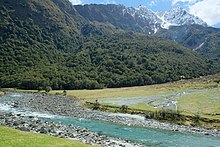Matukituki
| Matukituki River | |
|---|---|

Matukituki River West Branch
|
|
| Country | New Zealand |
| Basin features | |
| Main source | Mount Aspiring National Park |
| River mouth |
Lake Wanaka 300 m (980 ft) |
| Physical characteristics | |
| Length | 50 km (31 mi) |
The Matukituki River is found in the Southern Alps of New Zealand's South Island. Both the West Branch and the East Branch originate from the Main Divide mountain ranges near Mount Aspiring and their largely glacier-fed waters flow for approximately 20 kilometres (12 mi) each before joining near Camerons Flat. After this confluence, the Matukituki River leaves the boundaries of Mount Aspiring National Park and continues for another 30 kilometres (19 mi) until it drains into Lake Wanaka at the lake's southwestern edge.
A total of six glaciers feed tributary streams to the Matukituki River, the biggest of them being the Upper Volta Glacier, Rob Roy Glacier, Maud Francis Glacier, and Avalanche Glacier.
From Camerons Flat onwards, the river is increasingly braided until it passes through a narrow gorge and under the West Wanaka bridge just before reaching Lake Wanaka.
Most of the Southern Alps started over 220 million years ago as sediment and rock on top of volcanic rocks on the seafloor. Intense heat and pressure consolidated the rock, and then uplifted it to form the Main Divide. The present landscape was shaped by glacial processes during the ice ages, when huge glaciers filled and scoured out the valleys.
The area around Mount Aspiring (called Tititea by the Māori) has a long history of Māori tribes coming from as far as Coastal Otago and the Foveaux Strait to the inland lakes to collect kakapo, kereru, kākā and tui from the forest. Moa would have also been present along the forest edges for the first 200 years of Māori settlement.
The historic Māori iwi of Kāti Mamoe and Ngāi Tahu both had named settlements around the shores of Lakes Wanaka and Hāwea, including Nehenehe on the northern banks of the mouth of the Matukituki River. Ovens for cooking tī kōuka (cabbage tree) roots have been found at several sites on the lake shore.
...
Wikipedia
